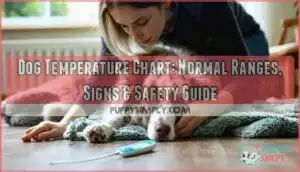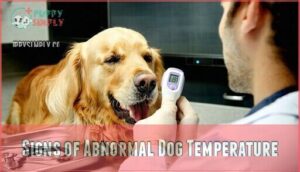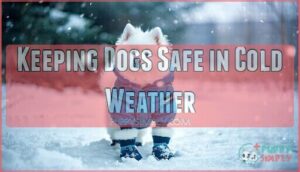This site is supported by our readers. We may earn a commission, at no cost to you, if you purchase through links.

This guide breaks down temperature ranges, warning signs, and practical steps to keep your dog safe in any weather.
Table Of Contents
- Key Takeaways
- Normal Dog Temperature Ranges
- How Dogs Regulate Body Temperature
- Signs of Abnormal Dog Temperature
- Taking a Dog’s Body Temperature
- Safe Temperature Guidelines for Dog Walking
- Protecting Dogs in Hot Weather
- Keeping Dogs Safe in Cold Weather
- When to Seek Veterinary Attention
- Frequently Asked Questions (FAQs)
- What should I do if my dog’s temperature is outside the normal range?
- What are the risks of supplementing calcium during pregnancy?
- How can I determine when my dog will give birth?
- Can I take my dog’s temperature at home?
- What signs indicate that my dog may have a fever?
- What causes fever in dogs and is it contagious?
- Can stress or anxiety affect dog body temperature?
- Do certain medications impact a dogs temperature regulation?
- How often should healthy dogs have temperature checks?
- Are infrared thermometers accurate for measuring dog temperature?
- Conclusion
Key Takeaways
- Your dog’s normal temperature sits between 100°F and 103.8°F, but puppies run cooler (97-102.5°F) and can’t regulate heat well until they’re older, so you’ll need to watch them more closely in any weather.
- Dogs cool themselves primarily through panting since they barely sweat, and breeds with short noses like Bulldogs struggle with this mechanism, making them more vulnerable to overheating in hot weather.
- Temperature above 104°F or below 99°F requires immediate veterinary attention, and you should start first aid right away—cool water on paws and belly for fever, warm blankets for hypothermia—while getting your dog to the vet.
- Walk timing matters as much as temperature: pavement above 85°F can burn paws in seconds, so stick to dawn or dusk walks in summer and use protective boots in winter to prevent frostbite and salt irritation.
Normal Dog Temperature Ranges
Your dog’s normal body temperature is a key indicator of health, but it varies based on age and other factors. Knowing what’s typical helps you spot problems early.
Here’s what you need to know about temperature ranges for adult dogs, puppies, and different breeds.
Adult Dog Temperature Chart
An adult dog’s normal temperature sits between 100.0°F and 103.8°F—slightly warmer than your own, and a key indicator of their overall health. This normal dog temperature range stays consistent across most breeds, though activity levels, hydration impact, and environmental factors can cause temporary shifts.
Age temperature differences matter less in adults than puppies, but your dog’s body temperature still reflects their well-being at any life stage.
Puppy Temperature Chart
Puppies run cooler than adults—usually between 97°F and 102.5°F during their first few weeks of life—because their temperature regulation systems are still developing. Here’s what you need to know about puppy body temperature by age:
- Newborn puppies (0-2 weeks): 95-99°F—they can’t regulate temperature yet and need external warmth
- Weaning puppies (3-4 weeks): 97-100°F—gradually improving control
- Older puppies (5-8 weeks): 99-102°F—approaching normal adult range
- Puppy hypothermia occurs below 94°F and requires immediate warming
- Puppy hyperthermia above 103°F signals overheating or illness
Vaccination impact can temporarily raise temperature by 1-2°F for 24-48 hours.
Environmental temperature for puppies matters more than for adults—keep their space between 75-85°F during early weeks. Monitor puppy health concerns closely since temperature swings indicate problems faster in young dogs.
Breed and Size Variations
Your dog’s breed and size influence how they react to temperature, though their core range stays the same (100-103.8°F). Small dogs lose heat faster due to their higher surface-area-to-body-mass ratio, making breeds like Chihuahuas more vulnerable to cold. Large breeds with thick coats—think Huskies or Malamutes—tolerate winter better but struggle in heat. Body shape matters too: short-nosed breeds (Bulldogs, Pugs) can’t cool efficiently through panting.
Activity impact compounds these breed characteristics, since high-energy dogs generate more internal heat during exercise. A healthy adult dog’s normal temperature range is 99.5°F to 102.5°F.
How Dogs Regulate Body Temperature
Dogs have a built-in cooling system that works differently than yours does. Their bodies use several clever methods to stay comfortable when temperatures shift.
Understanding how your dog regulates heat and cold can help you recognize when they’re struggling to keep up.
Thermoregulation Mechanisms
Your dog’s body operates like an intricate climate control system, orchestrated by the hypothalamus in the brain. Hypothalamic control centers detect temperature changes and trigger peripheral responses through blood vessel adjustments in the skin.
Body mass affects how efficiently your dog dissipates heat—larger dogs cool differently than smaller ones. Adaptive mechanisms like seeking shade and metabolic adjustments during exercise help maintain balance.
Dog thermoregulation mechanisms work through panting and body temperature regulation to keep your pet comfortable. A dog’s thermal regulatory capacity is essential for maintaining homeostasis.
Role of Panting and Sweating
When your dog’s tongue hangs out and their chest heaves rapidly, they’re not just catching their breath—they’re activating their primary cooling system. Panting mechanics drive evaporative cooling as moisture evaporates from the tongue and respiratory tract. Unlike humans, dogs have minimal sweat glands—only in paw pads—making panting their primary thermoregulation tool.
Cooling efficiency depends on:
- Breed differences: Brachycephalic breeds (like Bulldogs) struggle with effective panting
- Humidity impact: High moisture in air reduces evaporative cooling
- Body temperature regulation: Panting can exchange heat 10-20 times faster than normal breathing
Environmental Adaptations
Your dog’s wild ancestors didn’t have climate-controlled homes, so evolution equipped them with built-in adaptations that kick in when temperatures swing. Coat thickness and breed origins determine how your dog tolerates extreme temperatures—Huskies thrive in cold while Chihuahuas need extra warmth.
| Environmental Factor | Canine Adaptation |
|---|---|
| Seasonal Changes | Double coats shed or thicken |
| Regional Variations | Acclimatization process over weeks |
| Humidity Levels | Behavioral adaptations (seeking shade) |
| Altitude Differences | Enhanced body temperature regulation |
| Temperature Extremes | Metabolic adjustments reduce dog health risks |
Signs of Abnormal Dog Temperature
Your dog’s body sends clear signals when something’s off with their temperature. Recognizing these signs early can help you respond before a minor issue becomes an emergency.
Here’s what to watch for when your dog’s temperature climbs too high, drops too low, or triggers changes in how they look and act.
Symptoms of Fever (Hyperthermia)
Fever turns your dog’s internal thermostat dangerously high, and the signs can escalate quickly. You’ll notice excessive panting first, often with a bright red tongue and gums. Loss of appetite, lethargy, and vomiting commonly follow.
As hyperthermia worsens, diarrhea, stumbling, and even seizures may occur. If your dog’s temperature climbs above 102.5°F, contact your veterinarian immediately—high temperatures demand prompt professional attention.
Signs of Hypothermia
Cold temperatures drop your dog’s core heat to dangerous levels, and spotting the early warning signs can save their life. Watch for intense shivering that won’t stop—it’s your dog’s first defense against low temperature.
Lethargy signs follow, with stumbling and slow, shallow breathing changes. Check their gum color; pale or blue-gray gums signal hypothermia.
Muscle stiffness and extreme weakness mean cold weather has pushed them into critical danger.
Behavioral and Physical Changes
Dogs don’t just run a fever or catch a chill—they’ll show you something’s wrong through changes you can see and feel right away. Hypothermic pets grow lethargic and withdrawn, while hyperthermic pets can’t stop panting. Shivering signals cold stress, and excessive panting changes point to overheating.
You’ll notice appetite shifts, with your dog refusing food or water. Check their gum color and coat condition—these physical signs reveal what’s happening inside.
Taking a Dog’s Body Temperature
Taking your dog’s temperature at home is straightforward with the right tools and technique. You’ll need to choose between a rectal thermometer for the most accurate reading or a digital ear thermometer for convenience.
Here’s how to safely measure your dog’s temperature and get reliable results.
Types of Thermometers
Choosing the right thermometer can make the difference between a quick, accurate reading and a wrestling match with your anxious pup. Digital thermometers are your best bet—they’re fast and easy to read. Rectal thermometers give the most accurate results, while digital ear thermometers offer a less invasive option.
Skip mercury or glass thermometers, as they break easily and pose safety risks. Infrared thermometers work from a distance but aren’t always reliable for pets.
Rectal Vs. Digital Ear Technique
Once you’ve picked your thermometer, you’ll need to decide between the rectal method—which is more accurate but less comfortable for your dog—and the ear method, which is gentler but can give inconsistent readings.
Rectal thermometers are the best way for accuracy comparison, delivering reliable results within seconds. Digital ear technique wins on comfort levels and user experience, though ear wax or improper placement can throw off readings.
Cost analysis? Both options are affordable, with digital thermometers usually ranging from $10 to $30.
Step-by-Step Measurement Guide
Now that you know which method works best for your pup, here’s how to actually take their temperature without turning it into a wrestling match.
Thermometer preparation:
- Lubricate the tip with petroleum jelly
- Have a helper gently hold your dog still
- For rectal technique, lift the tail and insert about one inch
- For ear measurement, place snugly in the ear canal
- Reading results takes 10-60 seconds depending on your thermometer type
Normal temperature ranges are 100.0°F to 103.8°F. When repeat measurements show readings outside this range, contact your vet.
Safe Temperature Guidelines for Dog Walking
Walking your dog safely means paying attention to the outdoor temperature. Both extreme heat and cold can pose serious health risks, so knowing when conditions are dangerous helps you protect your pet.
Here’s what you need to think about before heading out the door.
Temperature Chart for Walks
Before you head out the door with your pup, you’ll want to check the thermometer—because the air temperature tells you whether it’s safe to walk, how long to stay out, and what precautions you’ll need to take.
Use this dog walking temperature chart to plan safe winter walks and monitor weather conditions:
| Temperature Range | Safety Level & Walk Duration |
|---|---|
| Below 20℉ (-7℃) | High risk—avoid walks; emergency planning needed |
| 20℉ to 32℉ (-7℃ to 0℃) | Caution—short walks only, check pavement temperatures |
| 32℉ to 45℉ (0℃ to 7℃) | Safe for most dogs with protective gear |
| 75℉ to 85℉ (24℃ to 29℃) | Monitor breed sensitivity and hydration |
| Above 85℉ (29℃) | High risk—limit walk duration greatly |
Breed, Age, and Health Considerations
Your dog’s breed, age, and health status determine how much temperature stress they can tolerate. Small breed dogs generally run warmer, from 100.5°F to 102.5°F, while large breeds often register at the lower end of normal—99.5°F to 101.5°F.
Puppies under three weeks need ambient temperatures around 85–90°F to stay safe, and senior dogs may struggle with temperature regulation as they age.
Brachycephalic breeds like Bulldogs can’t dissipate heat efficiently, and obese dogs face higher overheating risks because excess fat blocks heat loss. Dogs with heart or lung conditions also show impaired thermoregulation, making them vulnerable in extreme weather.
Duration and Time of Day Advice
Walking your dog at dawn or dusk cuts heat exposure by up to 50%, while midday summer walks can push pavement temperatures past 120°F—hot enough to burn paws in seconds. Keep walks under 15 minutes when temperatures exceed 85°F, and extend duration during cooler months with proper environmental factors affecting dogs in mind.
Ideal walk duration depends on breed-specific needs and activity level—puppies and seniors need shorter outings, while working breeds tolerate longer exercise.
Protecting Dogs in Hot Weather
Hot weather can be dangerous for your dog, especially when temperatures climb above 85°F. You’ll need to watch for warning signs, keep your pet cool and hydrated, and protect sensitive paws from hot surfaces.
Here’s what you need to know to keep your dog safe when the mercury rises.
Signs of Overheating and Heatstroke
When your dog’s body starts overheating, it’s like a car engine without coolant—systems break down fast, and the damage can be irreversible. Watch for panting excessively with a frantic quality, bright red gums color, drooling, and changes in mental state like confusion or wobbliness. Heat stroke brings vomiting, collapse, and seizure risk.
When a dog overheats, systems fail fast—watch for frantic panting, bright red gums, confusion, and collapse
If you spot these signs of overheating, immediate actions matter—move your dog to shade, offer water, and seek veterinary attention now.
Hydration and Shade Tips
Preventing heat emergencies comes down to two simple, non-negotiable essentials: fresh water within reach and a cool spot out of direct sun. Here’s how to make summer safer:
- Water bowl placement matters—position multiple bowls in shaded areas where your dog rests
- Portable water options like collapsible bowls guarantee hydration during walks
- Shaded resting spots under trees or umbrellas protect from direct heat
- Cooling mats lower body temperature when your dog lies down
- Electrolyte supplements can help replace what’s lost through panting, but consult your vet first
These steps reduce heat stroke and dehydration risk considerably.
QUMY Dog Boots Paw Protection
Hot pavement can burn your dog’s paws in seconds, turning a routine walk into a painful injury that protective boots prevent entirely. QUMY dog booties use anti-slip rubber boot material that shields paws from scorching asphalt during summer dog walks.
Check the sizing guide carefully—proper paw comfort depends on snug fit without restricting movement.
These boots address multiple terrain suitability needs and offer decent boot lifespan with regular use, making them essential winter safety gear too.
Keeping Dogs Safe in Cold Weather
Cold weather brings unique risks that many dog owners underestimate. Your dog can develop hypothermia, suffer paw injuries from ice and salt, or struggle in freezing conditions if you’re not prepared.
Here’s what you need to know to keep your dog safe when temperatures drop.
Hypothermia Warning Signs
Your dog’s body might be quietly signaling danger when temperatures drop, and catching these warning signs early can save their life. Watch for shivering intensities that escalate from mild to severe, lethargy levels that make your dog seem unusually tired, and mental dullness where they appear confused.
Check their gums—pale gums indicate trouble. Notice if their breathing slows down. These signs of dog hypothermia demand immediate action to protect your dog in cold weather.
Paw Care and Protective Gear
Cold pavement, ice, and salt can wreak havoc on your dog’s paws, so protection isn’t optional—it’s essential. Dog booties made from durable boot material shield against paw injuries and frostbite.
Apply paw balm or foot wax before walks for seasonal protection. Keep nails trimmed—overgrown nails make walking on ice painful.
Proper paw protection prevents injury and keeps your dog comfortable during winter outings.
Winter Walking Safety Tips
Once you’ve got paw protection sorted out, you’ll want to follow a few practical guidelines to make those winter walks safer and more comfortable for your dog. Keep walks short when temperatures drop below 20°F—smaller dog breeds and puppies feel the cold faster. Avoid icy pavement and areas treated with salt, which irritates paws. Watch for frostbite prevention signs like limping or lifting paws. Layer winter gear on cold-sensitive breeds before each dog walk.
When to Seek Veterinary Attention
Knowing when your dog needs urgent care can make the difference between a quick recovery and a serious health crisis. Temperature extremes demand fast action, but the right first aid steps can stabilize your pet until help arrives.
Here’s what you need to watch for and how to respond when your dog’s temperature signals trouble.
Emergency Temperature Thresholds
If your dog’s temperature climbs above 104°F (40°C), you’re facing a fever that needs veterinary attention right away. Hyperthermia becomes life-threatening when body temperature exceeds 105.8°F (41°C), triggering urgent cooling intervention. At the other extreme, hypothermia below 99°F (37.2°C) demands immediate warming strategies and professional care. Emergency situations also arise when clinical symptoms like neurological changes, bleeding disorders, or stupor accompany abnormal temperature readings.
Housing regulations exist because temperature extremes—below 45°F or above 85°F for extended periods—pose serious risks requiring protective measures.
First Aid for Abnormal Temperature
Between knowing a temperature is dangerous and getting your dog to safety, those first moments of action can make all the difference.
For fever or signs of overheating, start cooling methods immediately:
- Move your dog to shade or air conditioning
- Apply cool (not ice-cold) water to paws, belly, and armpits
- Offer small amounts of water to treat dehydration
For hypothermia, use warming methods like blankets and body heat. Watch for shock management needs, then follow transport protocol to get veterinary attention fast.
Ongoing Monitoring and Care
After you’ve stabilized your dog’s temperature and gotten professional help, keeping an eye on recovery becomes part of the daily routine for the next several days. Daily checks of hydration levels, coat condition, and behavior changes help you catch problems early. Senior care may require more attention since older dogs don’t bounce back as fast.
| What to Monitor | What to Look For |
|---|---|
| Temperature chart readings | Return to normal range (100-103.8°F) |
| Signs of abnormal temperature | Lethargy, panting, shivering |
| Hydration levels | Skin elasticity, gum moisture |
| Behavior changes | Appetite, energy, alertness |
Your veterinary care team can guide ongoing dog health needs and pet health maintenance during recovery.
Frequently Asked Questions (FAQs)
What should I do if my dog’s temperature is outside the normal range?
If your dog’s temperature falls outside the normal range of 0°F to 8°F, contact your veterinarian immediately. Abnormal temperatures require veterinary care.
Monitor changes closely while seeking medical advice to prevent recurrence of concerning signs.
What are the risks of supplementing calcium during pregnancy?
Supplementing calcium during pregnancy can cause eclampsia risk, skeletal abnormalities in puppies, and milk fever after birth. Calcium overdose disrupts normal hormone regulation, creating health problems.
Veterinarian medical advice determines proper supplement timing to protect animal health and puppy health.
How can I determine when my dog will give birth?
Track your dog’s rectal temperature twice daily—a drop from around 101°F to 98-99°F signals labor within 24 hours. Watch for nesting behavior and restlessness as delivery approaches.
Schedule veterinary checks throughout the gestation period to monitor puppy health and confirm due dates.
Can I take my dog’s temperature at home?
Yes, you can take your dog’s temperature at home. Think of it as checking under the hood—a rectal thermometer gives the most accurate reading of your pet’s normal dog temperature range. Digital thermometers work best for taking a dog’s body temperature comfortably.
What signs indicate that my dog may have a fever?
Look for a warm, dry nose paired with lethargy and appetite changes. You might notice nasal discharge or coughing signs as fever symptoms develop.
If your dog’s body temperature rises above the normal dog temperature range, seek veterinary attention immediately.
What causes fever in dogs and is it contagious?
Fever in dogs usually stems from infection, inflammation, or immune system responses. While the fever itself isn’t contagious, underlying diseases like kennel cough or canine influenza can spread between pets.
You’ll need veterinary attention to identify medical problems and prevent contagion in multi-pet homes.
Can stress or anxiety affect dog body temperature?
Stress-induced hyperthermia can raise your dog’s body temperature slightly, usually by one to two degrees. Anxiety and fever responses activate behavioral thermoregulation, causing emotional temperature changes that usually resolve once your dog calms down.
Do certain medications impact a dogs temperature regulation?
Certain medications can disrupt your dog’s natural temperature regulation. Anesthesia impact, drug-induced fever, and specific drug classes like steroids or sedatives may alter temperature sensitivity.
Medication side effects vary based on health conditions and health status, so always seek veterinary advice about canine health concerns.
How often should healthy dogs have temperature checks?
For healthy dogs, you don’t need routine temperature checks at home. Monitor your dog’s behavior and overall wellbeing instead.
Take your dog’s body temperature only when you notice signs of illness or discomfort. Your veterinarian will check normal dog temperature during annual wellness exams for preventative care and early detection.
Are infrared thermometers accurate for measuring dog temperature?
Infrared thermometers aren’t reliable for taking a dog’s body temperature. Fur interference and environmental factors limit clinical validation.
For accurate temperature measurement of pets, normal body temperature readings require rectal thermometers—the preferred method that matters most.
Conclusion
Think of a dog temperature chart as your canine compass—it points you toward health when you know how to read it. A few degrees can separate a happy afternoon from an emergency room visit, so checking baselines matters.
Watch for subtle shifts in behavior, trust your instincts when something feels off, and don’t hesitate to measure temperature if your dog seems unwell.
Keep this chart handy, stay alert to warning signs, and you’ll catch problems early enough to protect the pup you love.
- https://www.gfk.com/insights/mans-best-friend-global-pet-ownership-and-feeding-trends
- https://doi.org/10.1126/science.aao4776
- https://stacker.com/stories/2454/origins-50-most-popular-dog-breeds
- https://www.thrivepetcare.com/locations/florida/jacksonville/capital-veterinary-specialists-jax
- https://www.extension.purdue.edu/extmedia/va/va-16-w.pdf
















